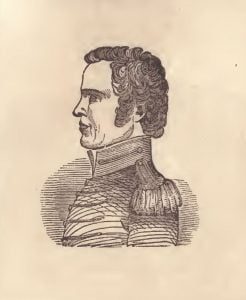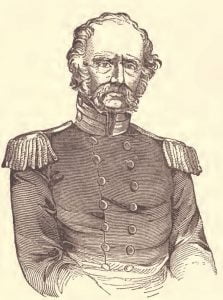After the close of the war with Great Britain, in 1815, when the British forces were withdrawn from the Florida’s, Edward Nicholls, formerly a colonel, and James Woodbine, a captain in the British service, who had both been engaged in exciting the Indians and Blacks to hostility, remained in the territory for the purpose of forming combinations against the southwestern frontier of the United States. Nicholls even went so far as to assume the character of a British agent, promising the Creeks the assistance of the British forces if they would rise and assert their claim to the land which had been ceded to the United States.

As an aid in effecting their purposes, Nicholls and Woodbine erected a fort on the Appalachicola River, between East and West Florida, as a rendezvous for runaway Blacks and hostile Indians. In July, 1816, upwards of four hundred Blacks and Indians were collected at this place, which was strong by its position, well supplied with ammunition and provisions, and with twelve pieces of artillery. To break up this horde of outlaws, Colonel Clinch, with a detachment of United States troops and five hundred friendly Indians, under the celebrated McIntosh, proceeded from the head waters of the Appalachicola, and laid siege to the fort on the land side. After exacting an oath from their followers not to suffer an American to approach the fort alive, Nicholls and Woodbine left the fort to their keeping.
To supply Colonel Clinch’s forces with munitions and provisions for the siege, two schooners, from New Orleans, proceeded up the river on the 10th of July, under convoy of two gun boats Near the fort, a watering party of seven men from the schooners, was surprised by a party of the enemy. Five were killed, one escaped, and one was captured, tortured and put to death. The commander of the gun boats was advised not to attempt any offensive operations; but he advanced near enough to commence the firing of hot shot, one of which, entering the principal magazine, blew up the fort. The destruction was complete. Two hundred and seventy of the enemy were killed, most of the remainder badly wounded, and only three of the whole number remained unhurt. An immense quantity of arms and ammunition fell into the hands of the fortunate victors; and two chiefs, who had directed the torture of the American prisoners, were given to the tender mercies of McIntosh’s Indians. The savage horde of West Florida was thus broken up, and the war terminated in this quarter.

In the fall of 1817, the family of Mr. Garrett, in East Florida, was attacked during his absence from home, and his wife and two children butchered. Soon after, a man named McKrimmon, was captured, and tied to the stake preparatory to being burned. He was rescued only through the intercession of one Milly, daughter of the chief Hillishago, who, like Pocahontas, rushed towards her father, and implored him to spare the prisoner. Being subsequently ransomed, he married his deliverer.
In November, General Gaines, commander in Florida, received orders from Washington, to negotiate with the Creeks, in order to induce them to remove to the country given to them by the United States. This the Indians refused to do; and when their chief, Hornetlimed, was summoned by the general to appear at the fort, he answered by a haughty defiance. Next day, Major Twiggs was sent against the Indian town with one hundred and fifty men. After repelling an attack on the road and killing several of the assailants, he reached the town and found it deserted.

After this affair, General Gaines dispatched Major Muhlenburg, from the headquarters at Fort Scott, to Mobile, with three vessels, for the purpose of obtaining provisions. Beside the crew, he had on board a number of volunteers’ wives and children. Sickness obliged him to halt on the Appalachicola, where he was soon reinforced by forty men, under Lieutenant Scott. The major detached half of the crew, for his own use, and placing seven women, four children, and his sick on board the lieutenants’ boat, he sent him back to Fort Scott. When near Flint River, the party was attacked by some savages, under Hornetlimed, and all were killed except six soldiers, who escaped, and one woman made prisoner. The scalps were taken to the Mickasuky village.
On receiving intelligence of this outrage, the secretary of war wrote to General Jackson, ordering him to repair immediately to Fort Scott, and take charge of the war. Eight hundred men were given to him, with authority to draw volunteers from the neighboring states, should that number be insufficient for the campaign. This communication reached General Jackson, January 12th, 1818. He then issued a proclamation to the Tennessee volunteers, to join him in the coming campaign. This was effectual, and a number were soon on their way to Fort Scott. On the 9th of March, the general himself arrived there, having on the road, mustered one thousand militia.

Finding the garrison destitute of provisions, he determined to win supplies from the enemy. As he pushed forward to the Appalachicola, he was joined by General Gaines, and built Fort Gadsden on the spot where the Indian fort which was blown up by Colonel Clinch had stood. On the 1st of April, he was joined by the Tennessee men. The same day he drove back a party of Indians and took possession of their village. Numerous scalps were found suspended on poles and in the wigwams.
About this time, a party, numbering five hundred Indians and Blacks, surrounded the Spanish fort, St. Marks, and demanded its surrender. This post was one of great importance, being strongly built, and having served formerly as the main depot of the Indians, and the scene of all their councils. As the Spanish garrison was very weak, Jackson determined to anticipate the enemy, and accordingly marched to the fort, and took possession without opposition, sending the garrison and authorities to Pensacola. Here he captured, the chiefs Hornetlimed and Hillishago, both of whom were hung. Arbuthnot was also captured.
After garrisoning the captured station, General Jackson proceeded against the Suwanee towns, where he arrived April 16th. After a slight resistance in which two Indians were taken and eleven killed, the settlement was taken, the huts destroyed, and some provisions secured. Two days after, Ambrister was captured. On the 22d a court of inquiry convened for the trial of this man and Arbuthnot, and, after six days’ session, found them guilty of inciting the Indians to aggression, and gave as their opinion that they were worthy of death. General Jackson sentenced Arbuthnot to be hung, and Ambrister to be shot. The sentence was executed on the 29th. On the same day the general returned to Fort Gadsden.
Intelligence now arrived that the defeated Seminoles were mustering near Pensacola. It was also rumored that they were assisted and encouraged by the Spanish garrison at that place. Although Spain was then at peace with the United States, General Jackson resolved on marching into the territory, and capturing the garrison at Pensacola. Accordingly he left Fort Gadsden on the 10th of May, at the head of twelve hundred men, and on the 22d arrived near Pensacola. On notifying the Spanish governor, he was ordered to quit the country. Disregarding this, he entered the city on the 24th, and immediately commenced operations for assaulting Fort Barrancas; whither the governor with his small force had retired. A bombardment of this was kept up until the 27th, when it surrendered, and the Spanish authorities were sent to Havana. Soon after General Jackson took possession of the whole territory, garrisoned different stations, and broke up all the Indian villages. He then retired to the Hermitage, in Tennessee, leaving the command with General Gaines, who, under his orders, speedily took possession of St. Augustine.

President Monroe, in his message of November, 1818, thus speaks of the condition of affairs in Spanish Florida.
“A state of things has existed in the Florida’s, the tendency of which has been obvious to all who have paid the slightest attention to the progress of affairs in that quarter. Throughout the whole of those provinces to which the Spanish title extends, the government of Spain has scarcely been felt. Its authority has been confined almost exclusively to the walls of Pensacola and St. Augustine, within which only small garrisons have been maintained. Adventurers from every country, fugitives from justice, and absconding slaves, have found an asylum there. Several tribes of Indians, strong in the number of their warriors, remarkable for their ferocity, and whose settlements extend to our limits, inhabit those provinces. These different hordes of people, connected together, disregarding, on the one side, the authority of Spain, and protected by an imaginary line which separates Florida from the United States, have violated our laws prohibiting the introduction of slaves, have practiced various frauds on our revenue, and committed every kind of outrage on our peaceable citizens, which their proximity to us enabled them to perpetrate. The invasion of Amelia Island last year by a email band of adventurers, not exceeding one hundred and fifty in number, who wrested it from the inconsiderable Spanish force stationed there, and held it several months, during which a single effort only was made to recover it, which failed, clearly proves how completely extinct the Spanish authority had become; as the conduct of those adventurers while in possession of the island as distinctly shows the pernicious purposes for which their combination had been formed.”
The forcible occupation of a neutral territory, elicited much attention in the United States, and subjected General Jackson to much censure. The government promptly surrendered the captured posts to the Spanish crown, but did not think proper to call the general to account for his actions. The Seminole war, was, however, ended for that time; and the cession of Florida to the United States in 1819, put an end to all difficulties with Spain.
